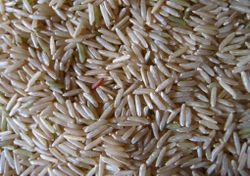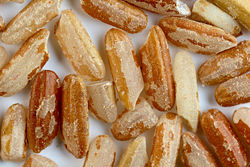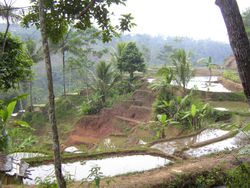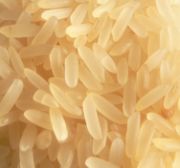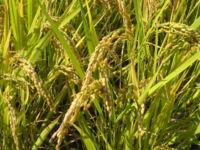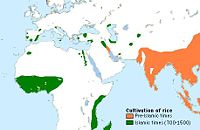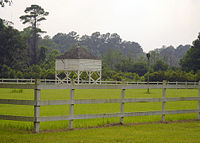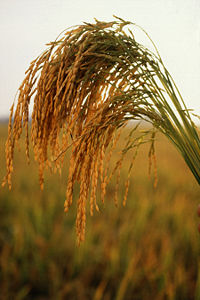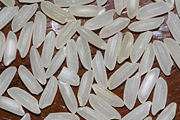Rice
2008/9 Schools Wikipedia Selection. Related subjects: Food
| Rice | ||||||||||||
|---|---|---|---|---|---|---|---|---|---|---|---|---|
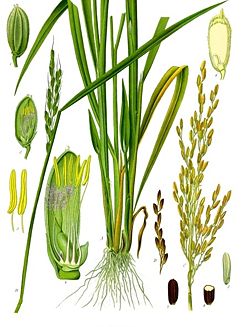 Oryza sativa
|
||||||||||||
| Scientific classification | ||||||||||||
|
||||||||||||
| Species | ||||||||||||
|
| Rice, white, long-grain, regular, raw, unenriched Nutritional value per 100 g (3.5 oz) |
||||||||||||||||||||||||||||||||||
|---|---|---|---|---|---|---|---|---|---|---|---|---|---|---|---|---|---|---|---|---|---|---|---|---|---|---|---|---|---|---|---|---|---|---|
| Energy 370 kcal 1530 kJ | ||||||||||||||||||||||||||||||||||
|
||||||||||||||||||||||||||||||||||
| Percentages are relative to US recommendations for adults. Source: USDA Nutrient database |
||||||||||||||||||||||||||||||||||
Rice is a cereal foodstuff which forms an important part of the diet of many people worldwide.
Domesticated rice comprises two species of food crops in the Poaceae ("true grass") family, Oryza sativa and Oryza glaberrima. These plants are native to tropical and subtropical southern Asia and southeastern Africa.
The name wild rice is usually used for species of the different but related genus Zizania, both wild and domesticated, although the term may be used for primitive or uncultivated varieties of Oryza.
Rice is grown as a monocarpic annual plant, although in tropical areas it can survive as a perennial and can produce a ratoon crop and survive for up to 20 years. Rice can grow to 1–1.8 m tall, occasionally more depending on the variety and soil fertility. The grass has long, slender leaves 50–100 cm long and 2–2.5 cm broad. The small wind-pollinated flowers are produced in a branched arching to pendulous inflorescence 30–50 cm long. The edible seed is a grain (caryopsis) 5–12 mm long and 2–3 mm thick.
Rice is a staple food for a large part of the world's human population, especially in tropical Latin America, and East, South and Southeast Asia, making it the second-most consumed cereal grain. A traditional food plant in Africa, Rice has the potential to improve nutrition, boost food security, foster rural development and support sustainable landcare. Rice provides more than one fifth of the calories consumed worldwide by humans. In early 2008, some governments and retailers began rationing supplies of the grain due to fears of a global rice shortage.
Rice cultivation is well-suited to countries and regions with low labor costs and high rainfall, as it is very labor-intensive to cultivate and requires plenty of water for cultivation. On the other hand, mechanized cultivation is extremely oil-intensive, more than other food products with the exception of beef and dairy products. Rice can be grown practically anywhere, even on a steep hill or mountain. Although its species are native to South Asia and certain parts of Africa, centuries of trade and exportation have made it commonplace in many cultures.
The traditional method for cultivating rice is flooding the fields with or after setting the young seedlings. This simple method requires sound planning and servicing of the water damming and channeling, but reduces the growth of less robust weed and pest plants that have no submerged growth state, and deters vermin. While with rice growing and cultivation the flooding is not mandatory, all other methods of irrigation require higher effort in weed and pest control during growth periods and a different approach for fertilizing the soil.
Etymology
According to the Microsoft Encarta Dictionary (2004) and the Chambers Dictionary of Etymology (1988), the word rice has an Indo-Iranian origin. It came to English from Greek óryza, via Latin oriza, Italian riso and finally Old French ris (the same as present day French riz).
It has been speculated that the Indo-Iranian vrihi itself is borrowed from a Dravidian vari (< PDr. *warinci) or even a Munda language term for rice, or the Tamil name arisi (அரிசி) from which the Arabic ar-ruzz, from which the Portuguese and Spanish word arroz originated.
Preparation as food
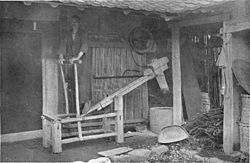
The seeds of the rice plant are first milled using a rice huller to remove the chaff (the outer husks of the grain). At this point in the process, the product is called brown rice. The milling may be continued, removing the 'bran' (i.e. the rest of the husk and the germ), thereby creating white rice. White rice, which keeps longer and is preferred by most, lacks some important nutrients; in a limited diet which does not supplement the rice, brown rice helps to prevent the deficiency disease beriberi.
White rice may be also buffed with glucose or talc powder (often called polished rice, though this term may also refer to white rice in general), parboiled, or processed into flour. White rice may also be enriched by adding nutrients, especially those lost during the milling process. While the cheapest method of enriching involves adding a powdered blend of nutrients that will easily wash off (in the United States, rice which has been so treated requires a label warning against rinsing), more sophisticated methods apply nutrients directly to the grain, coating the grain with a water insoluble substance which is resistant to washing.
Despite the hypothetical health risks of talc (such as stomach cancer), talc-coated rice remains the norm in some countries due to its attractive shiny appearance, but it has been banned in some and is no longer widely used in others such as the United States. Even where talc is not used, glucose, starch, or other coatings may be used to improve the appearance of the grains; for this reason, many rice lovers still recommend washing all rice in order to create a better-tasting rice with a better consistency, despite the recommendation of suppliers. Much of the rice produced today is water polished.
Rice bran, called nuka in Japan, is a valuable commodity in Asia and is used for many daily needs. It is a moist, oily inner layer which is heated to produce an oil. It is also used as a pickling bed in making rice bran pickles and Takuan.
Raw rice may be ground into flour for many uses, including making many kinds of beverages such as amazake, horchata, rice milk, and sake. Rice flour does not contain gluten and is suitable for people on a gluten-free diet. Rice may also be made into various types of noodles. Raw wild or brown rice may also be consumed by raw-foodist or fruitarians if soaked and sprouted (usually 1 week to 30 days).
Processed rice seeds must be boiled or steamed before eating. Cooked rice may be further fried in oil or butter, or beaten in a tub to make mochi.
Rice is a good source of protein and a staple food in many parts of the world, but it is not a complete protein: it does not contain all of the essential amino acids in sufficient amounts for good health, and should be combined with other sources of protein, such as nuts, seeds, beans or meat.
Rice, like other cereal grains, can be puffed (or popped). This process takes advantage of the grains' water content and typically involves heating grains in a special chamber. Further puffing is sometimes accomplished by processing pre-puffed pellets in a low- pressure chamber. The ideal gas law means that either lowering the local pressure or raising the water temperature results in an increase in volume prior to water evaporation, resulting in a puffy texture. Bulk raw rice density is about 0.9 g/cm³. It decreases more than tenfold when puffed.
Cooking
There are many varieties of rice; for many purposes the main distinction is between long- and short-grain rice. The grains of long-grain rice tend to remain intact after cooking; short-grain rice becomes more sticky. Short-grain rice is used for sweet dishes, and for risotto and many Spanish dishes.
Rice is cooked by boiling or steaming, and absorbs water during cooking. It can be cooked in just as much water as it absorbs (the absorption method), or in a large quantity of water which is drained before serving (the rapid-boil method). Electric rice cookers, popular in Asia and Latin America, simplify the process of cooking rice. Rice is often heated in oil before boiling, or oil is added to the water; this is thought to make the cooked rice less sticky.
In Arab cuisine rice is an ingredient of many soups and dishes with fish, poultry and meat. It is also used to stuff vegetables or is wrapped in grape leaves. When combined with milk, sugar and honey, it is used to make desserts. In some regions, such as Tabaristan, bread is made using rice flour. Medieval Islamic texts spoke of medical uses for the plant.
Also extremely popular are combination cooking methods; for example fried rice is boiled or steamed rice stir-fried in oil.
Rice may also be made into rice porridge (also called congee or rice gruel) by adding more water than usual, so that the cooked rice is saturated with water to the point that it becomes very soft, expanded, and fluffy. Rice porridge is commonly eaten as a breakfast food, and is also a traditional food for the sick.
Rice may be soaked prior to cooking, which decreases cooking time. For some varieties, soaking improves the texture of the cooked rice by increasing expansion of the grains.
In some countries parboiled rice, also known as Minute rice or easy-cook rice, is popular. Parboiled rice is subjected to a steaming or parboiling process while still a brown rice. This causes nutrients from the outer husk to move into the grain itself. The parboil process causes a gelatinisation of the starch in the grains. The grains become less brittle, and the colour of the milled grain changes from white to yellow. The rice is then dried, and can then be milled as usual or used as brown rice. Milled parboiled rice is nutritionally superior to standard milled rice. Parboiled rice has an additional benefit in that it does not stick to the pan during cooking as happens when cooking regular white rice.
A nutritionally superior method of preparing brown rice known as GABA Rice or GBR (Germinated Brown Rice) may be used. This involves soaking washed brown rice for 20 hours in warm water (38 °C or 100 °F) prior to cooking it. This process stimulates germination, which activates various enzymes in the rice. By this method, a result of research carried out for the United Nations Year of Rice, it is possible to obtain a more complete amino acid profile, including GABA.
Cooked rice can contain Bacillus cereus spores which produce an emetic toxin when left between 4-60 degrees Celsius . When storing cooked rice for use the next day, rapid cooling is advised to reduce the risk of contamination.
Production history
Genetic history
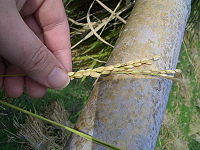
Two species of rice were domesticated, Asian rice (O. sativa) and African rice (O. glaberrima). According to Londo and Chiang, O. sativa appears to have been domesticated from wild (Asian) Oryza rice, Oryza rufipogon around the foothills of the Himalayas, with O. sativa var. indica on the Indian side and O. sativa var. japonica on the Chinese and Japanese side. The different histories have led to different ecological niches for the two main types of rice. Indica are mainly lowland rices, grown mostly submerged, throughout tropical Asia, while japonica are usually cultivated in dry fields, in temperate East Asia, upland areas of Southeast Asia and high elevations in South Asia. (Oka 1988)
Current genetic analysis suggests that O. sativa would be best divided into five groups, labeled indica, aus, aromatic, temperate japonica and tropical japonica. The same analysis suggests that indica and aus are closely related, as are tropical japonica, temperate japonica, and aromatic. Further analysis of the genetic material of various types of rice indicates that japonica was the first cultivar to emerge, followed by the indica, aus, and aromatic groups, whose genome did show significant differences in age. Within the japonica group, there is some genetic evidence that temperate japonica is derived from tropical japonica.
Other studies have suggested that there are three groups of Oryza sativa cultivars: the short-grained "japonica" or "sinica" varieties, exemplified by Japanese rice; the long-grained " indica" varieties, exemplified by Basmati rice; and the broad-grained "javonica" varieties, which thrive under tropical conditions (Zohary and Hopf, 2000). The earliest find site for the japonica variety, dated to the 5th millennium BCE, was in the earliest phases of the Hemudu culture on the south side of Hangzhou Bay in China, but was found along with japonica types.
Global history and methodology of cultivating rice
India
According to the Encyclopædia Britannica:
The origin of rice culture has been traced to India in about 3000 BCE. Rice culture gradually spread westward and was introduced to southern Europe in medieval times. With the exception of the type called upland rice, the plant is grown on submerged land in the coastal plains, tidal deltas, and river basins of tropical, semitropical, and temperate regions. The seeds are sown in prepared beds, and when the seedlings are 25 to 50 days old, they are transplanted to a field, or paddy, that has been enclosed by levees and submerged under 5 to 10 cm (2 to 4 inches) of water, remaining submerged during the growing season.
Wild Oryza rice appeared in the Belan and Ganges valley regions of northern India as early as 4530 BCE and 5440 BCE respectively. Agricultural activity during the second millennium BC included rice cultivation in the Kashmir and Harrappan regions. Mixed farming was the basis of Indus valley economy. Farmers planted their crops in integrated fields. Rice, grown on the west coast, was cultivated in the Indus valley. Rice, along with barley, meat, dairy products and fish constituted the dietary staple of the ancient Dravidian people.
There is mention of ApUpa, Puro-das and Odana (rice-gruel) in the Rig Veda, terms that refer to rice dishes, The rigvedic commentator Sayana refers to "tandula" when commenting on RV 1.16.2., which means rice. The Rigvedic term dhana (dhanaa, dhanya) means rice. Both Charaka and Sushruta mention rice in detail. The Arthasastra discusses aspects of rice cultivation. The Kashyapiyakrishisukti by Kashyapa is the most detailed ancient Sanskrit text on rice cultivation.
Continental East Asia
Z. Zhao, a Chinese palaeoethnobotanist, hypothesizes that people of the Late Pleistocene began to collect wild Oryza rice. Zhao explains that the collection of wild rice from an early date eventually led to its domestication and then the exclusive use of domesticated rice strains by circa 6400 BC at the latest. Stone tool evidence from the Yunchanyan site in Hunan province suggests the possibility that Early Neolithic groups cultivated rice as early as circa 9000 BC. Crawford and Shen point out that calibrated radiocarbon dates show that direct evidence of the earliest cultivated rice is no older than 7000 BC. Jared Diamond, a biologist and popular science author, summarizes some of the research done by archaeologists and estimates that the earliest attested domestication of rice took place in China by 7500 BC.
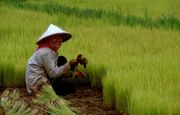
An early archaeological site from which rice was excavated is Pengtoushan in the Hupei basin. This archaeological site was dated by AMS radiocarbon techniques to 6400–5800 BC (Zohary and Hopf 2000), but most of the Neolithic sites in China with finds of charred rice and radiocarbon dates are from 5000 BC or later. This evidence leads most archaeologists to say that large-scale dry-land rice farming began between 5000 and 4500 BC in the area of Yangtze Delta (for example Hemudu culture, discovered in 1970s), and the wet-rice cultivation began at approximately 2500 BC in the same area ( Liangzhu culture). It is now commonly thought that some areas such as the alluvial plains in Shaoxing and Ningbo in Zhejiang province are the cradle-lands of East Asian rice cultivation. Finally, ancient textual evidence of the cultivation of rice in China dates to 3000 years ago.
Bruce Smith of the Smithsonian Institution advises caution on the Chinese rice hypothesis. No morphological studies have been done to determine whether the grain was domesticated. According to Smith such a rice would have larger seeds compared to the wild varieties, and would have a strong rachis or spine for holding grain.
Korean peninsula and Japan
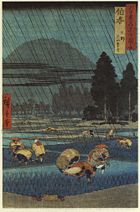
In 2003, Korean archaeologists alleged that they discovered burnt grains (domesticated rice) in Soro-ri, Korea, that predate the oldest grains in China. This find potentially challenges the mainstream explanation that domesticated rice originated in China. The media reports of the Soro-ri charred grains are brief and lack sufficient detail for archaeologists and scientists in related fields to properly evaluate the true meaning of this unusual find.
Reliable, mainstream archaeological evidence derived from palaeoethnobotanical investigations indicate that dry-land rice was introduced to Korea and Japan some time between 3500 and 1200 BC. The cultivation of rice in Korea and Japan during that time occurred on a small-scale, fields were impermanent plots, and evidence shows that in some cases domesticated and wild grains were planted together. The technological, subsistence, and social impact of rice and grain cultivation is not evident in archaeological data until after 1500 BC. For example, intensive wet- paddy rice agriculture was introduced into Korea shortly before or during the Middle Mumun Pottery Period (c. 850–550 BC) and reached Japan by the Final Jōmon or Initial Yayoi circa 300 BC.
Southeast Asia
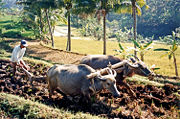
Rice is the staple for all classes in contemporary South East Asia, from Myanmar to Indonesia. In Indonesia, evidence of wild Oryza rice on the island of Sulawesi dates from 3000 BCE. The evidence for the earliest cultivation, however, comes from eighth century stone inscriptions from Java, which show kings levied taxes in rice. Divisions of labor between men, women, and animals that are still in place in Indonesian rice cultivation, can be seen carved into the ninth-century Prambanan temples in Central Java. In the sixteenth century, Europeans visiting the Indonesian islands saw rice as a new prestige food served to the aristocracy during ceremonies and feasts. Rice production in Indonesian history is linked to the development of iron tools and the domestication of water buffalo for cultivation of fields and manure for fertilizer. Once covered in dense forest, much of the Indonesian landscape has been gradually cleared for permanent fields and settlements as rice cultivation developed over the last fifteen hundred years.
In the Philippines, the greatest evidence of rice cultivation since ancient times can be found in the Cordilera Mountain Range of Luzon in the provinces of Apayao, Benguet, Mountain Province and Ifugao. The Banaue Rice Terraces (Tagalog: Hagdan-hagdang Palayan ng Banaue)are 2,000 to 3,000-year old terraces that were carved into the mountains by ancestors of the Batad indigenous people. It is commonly thought that the terraces were built with minimal equipment, largely by hand. The terraces are located approximately 1,500 meters (5000 ft) above sea level and cover 10,360 square kilometers (about 4,000 square miles) of mountainside. They are fed by an ancient irrigation system from the rainforests above the terraces. It is said that if the steps are put end to end it would encircle half the globe. The Rice Terraces (UNESCO World Heritage Site) are commonly referred to by Filipinos as the "Eighth Wonder of the World".
Evidence of wet rice cultivation as early as 2200 BC has been discovered at both Ban Chiang and Ban Prasat in Thailand.
By the 19th Century, encroaching European expansionism in the area increased rice production in much of South East Asia, and Thailand, then known as Siam. British Burma (now Myanmar) became the world's largest exporter of rice, from the turn of the 20th century up till the 1970s, when neighbouring Thailand exceeded Myanmar.
Africa
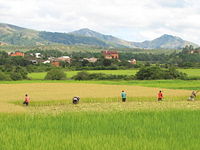
African rice has been cultivated for 3500 years. Between 1500 and 800 BC, O. glaberrima propagated from its original centre, the Niger River delta, and extended to Senegal. However, it never developed far from its original region. Its cultivation even declined in favour of the Asian species, possibly brought to the African continent by Arabs coming from the east coast between the 7th and 11th centuries CE.
In parts of Africa under Islam, rice was chiefly grown in southern Morocco. During the tenth century rice was also brought to east Africa by Muslim traders. Although, the diffusion of rice in much sub-Saharan Africa remains uncertain, Muslims brought it to the region stretching from Lake Chad to the White Nile.
Middle East
According to Zohary and Hopf (2000, p. 91), O. sativa was introduced to the Middle East in Hellenistic times, and was familiar to both Greek and Roman writers. They report that a large sample of rice grains was recovered from a grave at Susa in Iran (dated to the first century AD) at one end of the ancient world, while at the same time rice was grown in the Po valley in Italy. However, Pliny the Elder writes that rice (oryza) is grown only in "Egypt, Syria, Cilicia, Asia Minor and Greece" ( N.H. 18.19).
After the rise of Islam, rice was grown anywhere there was enough water to irrigate it. Thus, desert oases, river valleys, and swamp lands were all important sources of rice during the Muslim Agricultural Revolution.
In Iraq rice was grown in some areas of southern Iraq. With the rise of Islam it moved north to Nisibin, the southern shores of the Caspian Sea and then beyond the Muslim world into the valley of Volga. In Israel, rice came to be grown in the Jordan valley. Rice is also grown in Yemen.
Europe
The Muslims (later known as Moors) brought Asiatic rice to the Iberian Peninsula in the tenth century. Records indicate it was grown in Valencia and Majorca. In the case of Majorca, the rice cultivation stopped after the Christian conquest, although historians aren't certain.
Muslims also brought rice to Sicily, where it was an important crop.
After the middle of the 15th century, rice spread throughout Italy and then France, later propagating to all the continents during the age of European exploration.
United States
In 1694, rice arrived in South Carolina, probably originating from Madagascar. The Spanish brought rice to South America at the beginning of the 17th century.
In the United States, colonial South Carolina and Georgia grew and amassed great wealth from the slave labor obtained from the Senegambia area of West Africa and from coastal Sierra Leone. At the port of Charleston, through which 40% of all American slave imports passed, slaves from this region of Africa brought the highest prices, in recognition of their prior knowledge of rice culture, which was put to use on the many rice plantations around Georgetown, Charleston, and Savannah. From the slaves, plantation owners learned how to dyke the marshes and periodically flood the fields. At first the rice was milled by hand with wooden paddles, then winnowed in sweetgrass baskets (the making of which was another skill brought by the slaves). The invention of the rice mill increased profitability of the crop, and the addition of water power for the mills in 1787 by millwright Jonathan Lucas was another step forward. Rice culture in the southeastern U.S. became less profitable with the loss of slave labor after the American Civil War, and it finally died out just after the turn of the 20th century. Today, people can visit the only remaining rice plantation in South Carolina that still has the original winnowing barn and rice mill from the mid-1800's at the historic Mansfield Plantation in Georgetown, SC. The predominant strain of rice in the Carolinas was from Africa and was known as "Carolina Gold." The cultivar has been preserved and there are current attempts to reintroduce it as a commercially grown crop.
In the southern United States, rice has been grown in southern Arkansas, Louisana, and east Texas since the mid 1800s. Many Cajun farmers grew rice in wet marshes and low lying prairies. In recent years rice production has risen in North America, especially in the Mississippi River Delta areas in the states of Arkansas and Mississippi.
Rice cultivation began in California during the California Gold Rush, when an estimated 40,000 Chinese laborers immigrated to the state and grew small amounts of the grain for their own consumption. However, commercial production began only in 1912 in the town of Richvale in Butte County. By 2006, California produced the second largest rice crop in the United States, after Arkansas, with production concentrated in six counties north of Sacramento. Unlike the Mississippi Delta region, California's production is dominated by short- and medium-grain japonica varieties, including cultivars developed for the local climate such as Calrose, which makes up as much as eighty five percent of the state's crop.
References to wild rice in the Americas are to the unrelated Zizania palustris
More than 100 varieties of rice are commercially produced primarily in six states (Arkansas, Texas, Louisiana, Mississippi, Missouri, and California) in the U.S. According to estimates for the 2006 crop year, rice production in the U.S. is valued at $1.88 billion, approximately half of which is expected to be exported. The U.S. provides about 12% of world rice trade. The majority of domestic utilization of U.S. rice is direct food use (58%), while 16 percent is used in processed foods and beer respectively. The remaining 10 percent is found in pet food.
Australia
Although attempts to grow rice in the well-watered north of Australia have been made for many years, they have consistently failed because of inherent iron and manganese toxicities in the soils and destruction by pests.
In the 1920s it was seen as a possible irrigation crop on soils within the Murray-Darling Basin that were too heavy for the cultivation of fruit and too infertile for wheat.
Because irrigation water, despite the extremely low runoff of temperate Australia, was (and remains) very cheap, the growing of rice was taken up by agricultural groups over the following decades. Californian varieties of rice were found suitable for the climate in the Riverina, and the first mill opened at Leeton in 1951.
Even before this Australia's rice production greatly exceeded local needs, and rice exports to Japan have become a major source of foreign currency. Above-average rainfall from the 1950s to the middle 1990s encouraged the expansion of the Riverina rice industry, but its prodigious water use in a practically waterless region began to attract the attention of environmental scientists. These became severely concerned with declining flow in the Snowy River and the lower Murray River.
Although rice growing in Australia is exceedingly efficient and highly profitable due to the cheapness of land, several recent years of severe drought have led many to call for its elimination because of its effects on extremely fragile aquatic ecosystems. Politicians, however, have not made any plan to reduce rice growing in southern Australia.
Rice biotechnology
High-yielding varieties
The High Yielding Varieties are a group of crops created intentionally during the Green Revolution to increase global food production. Rice, like corn and wheat, was genetically manipulated to increase its yield. This project enabled labor markets in Asia to shift away from agriculture, and into industrial sectors. The first ‘modern rice’, IR8 was produced in 1966 at the International Rice Research Institute which is based in the Philippines at the University of the Philippines' Los Banos site. IR8 was created through a cross between an Indonesian variety named “Peta” and a Chinese variety named “Dee Geo Woo Gen.”
With advances in molecular genetics, the mutant genes responsible for reduced height(rht), gibberellin insensitive (gai1) and slender rice (slr1) in Arabidopsis and rice were identified as cellular signaling components of gibberellic acid (a phytohormone involved in regulating stem growth via its effect on cell division) and subsequently cloned. Stem growth in the mutant background is significantly reduced leading to the dwarf phenotype. Photosynthetic investment in the stem is reduced dramatically as the shorter plants are inherently more stable mechanically. Assimilates become redirected to grain production, amplifying in particular the effect of chemical fertilizers on commercial yield. In the presence of nitrogen fertilizers, and intensive crop management, these varieties increase their yield 2 to 3 times.
Potentials for the future
As the UN Millennium Development project seeks to spread global economic development to Africa, the ‘Green Revolution’ is cited as the model for economic development. With the intent of replicating the successful Asian boom in agronomic productivity, groups like the Earth Institute are doing research on African agricultural systems, hoping to increase productivity. An important way this can happen is the production of ‘ New Rices for Africa’ (NERICA). These rices, selected to tolerate the low input and harsh growing conditions of African agriculture are produced by the African Rice Centre, and billed as technology from Africa, for Africa. The NERICA have appeared in The New York Times ( October 10, 2007) and International Herald Tribune ( October 9, 2007), trumpeted as miracle crops that will dramatically increase rice yield in Africa and enable an economic resurgence.
Golden rice
German and Swiss researchers have engineered rice to produce Beta-carotene, with the intent that it might someday be used to treat vitamin A deficiency. Additional efforts are being made to improve the quantity and quality of other nutrients in golden rice. The addition of the carotene turns the rice gold.
Expression of human proteins
Ventria Bioscience has genetically modified rice to express lactoferrin, lysozyme, and human serum albumin which are proteins usually found in breast milk. These proteins have antiviral, antibacterial, and antifungal effects.
Rice containing these added proteins can be used as a component in oral rehydration solutions which are used to treat diarrheal diseases, thereby shortening their duration and reducing recurrence. Such supplements may also help reverse anaemia.
World production and trade
Production and export
| Top paddy rice producers–2006 (million metric ton) |
|
|---|---|
| 184 | |
| 137 | |
| 54 | |
| 44 | |
| 36 | |
| 29 | |
| 25 | |
| 15 | |
| 12 | |
| 11 | |
| 9 | |
| World Total | 635 |
| Source: UN Food & Agriculture Organisation (FAO) |
|
World production of rice has risen steadily from about 200 million tons of paddy rice in 1960 to 600 million tons in 2004. Milled rice is about 68% of paddy rice by weight. In the year 2004, the top three producers were China (26% of world production), India (20%), and Indonesia (9%).
World trade figures are very different, as only about 5–6% of rice produced is traded internationally. The largest three exporting countries are Thailand (26% of world exports), Vietnam (15%), and the United States (11%), while the largest three importers are Indonesia (14%), Bangladesh (4%), and Brazil (3%). Although China and India are the top two largest producers of rice in the world, both of countries consume the majority of the rice produced domestically leaving little to be traded internationally.
Price
In March to May of 2008, the price of rice rose greatly due to a rice shortage. In late April 2008, rice prices hit 24 cents a pound, twice the price that it was seven months earlier.
On the 30th of April, 2008, Thailand announced the project of the creation of the Organisation of Rice Exporting Countries (OREC) with the potential to develop into a price-fixing cartel for rice.
Rice consumption around the world
| Consumption of rice by country—2003/2004 (million metric ton) |
|
|---|---|
| 135 | |
| 85 | |
| 37 | |
| 26 | |
| 18 | |
| 10 | |
| 10 | |
| 9.7 | |
| 8.7 | |
| 8.1 | |
| 5.0 | |
| 3.9 | |
| Source: United States Department of Agriculture |
|
Between 1961 and 2002, per capita consumption of rice increased by 40%. Rice consumption is highest in Asia, where average per capita consumption is higher than 80 kg/person per year. In the subtropics such as South America, Africa, and the Middle East, per capita consumption averages between 30 and 60 kg/person per year. People in the developed West, including Europe and the United States, consume less than 10 kg/person per year.
Rice is the most important crop in Asia. In Cambodia, for example, 90% of the total agricultural area is used for rice production. See The Burning of the Rice by Don Puckridge for the story of rice production in Cambodia .
U.S. rice consumption has risen sharply over the past 25 years, fueled in part by commercial applications such as beer production. Almost one in five adult Americans now report eating at least half a serving of white or brown rice per day.
Environmental impacts
In many countries where rice is the main cereal crop, rice cultivation is responsible for most of the methane emissions. Farmers in some of the arid regions try to cultivate rice using groundwater bored through pumps, thus increasing the chances of famine in the long run. Rice also requires much more water to produce than other grains.
As sea levels rise, rice will become more inclined to remain flooded for longer periods of time. Longer stays in water cuts the soil off from atmospheric oxygen and causes fermentation of organic matter in the soil. During the wet season, rice cannot hold the carbon in anaerobic conditions. The microbes in the soil convert the carbon into methane which is then released through the respiration of the rice plant or through diffusion of water. Current contributions of methane from agriculture is ~15% of anthropogenic greenhouse gases, as estimated by the IPCC. Further rise in sea level of 10-85 centimeters would then stimulate the release of more methane into the air by rice plants. Methane is twenty times more effective as a greenhouse gas than carbon dioxide is.
Rice pests
Rice pests are any organisms or microbes with the potential to reduce the yield or value of the rice crop (or of rice seeds) (Jahn et al 2007). Rice pests include weeds, pathogens, insects, rodents, and birds. A variety of factors can contribute to pest outbreaks, including the overuse of pesticides and high rates of nitrogen fertilizer application (e.g. Jahn et al. 2005) . Weather conditions also contribute to pest outbreaks. For example, rice gall midge and army worm outbreaks tend to follow high rainfall early in the wet season, while thrips outbreaks are associated with drought ( Douangboupha et al. 2006).
One of the challenges facing crop protection specialists is to develop rice pest management techniques which are sustainable. In other words, to manage crop pests in such a manner that future crop production is not threatened (Jahn et al. 2001). Rice pests are managed by cultural techniques, pest-resistant rice varieties, and pesticides (which include insecticide). Increasingly, there is evidence that farmers' pesticide applications are often unnecessary (Jahn et al. 1996, 2004a,b) . By reducing the populations of natural enemies of rice pests (Jahn 1992), misuse of insecticides can actually lead to pest outbreaks (Cohen et al. 1994). Botanicals, so-called “natural pesticides”, are used by some farmers in an attempt to control rice pests, but in general the practice is not common. Upland rice is grown without standing water in the field. Some upland rice farmers in Cambodia spread chopped leaves of the bitter bush (Chromolaena odorata (L.)) over the surface of fields after planting. The practice probably helps the soil retain moisture and thereby facilitates seed germination. Farmers also claim the leaves are a natural fertilizer and helps suppress weed and insect infestations (Jahn et al. 1999).
Among rice cultivars there are differences in the responses to, and recovery from, pest damage ( Jahn et al. 2004c, Khiev et al. 2000). Therefore, particular cultivars are recommended for areas prone to certain pest problems. The genetically based ability of a rice variety to withstand pest attacks is called resistance. Three main types of plant resistance to pests are recognized (Painter 1951, Smith 2005): as nonpreference, antibiosis, and tolerance. Nonpreference (or antixenosis) (Kogan and Ortman 1978) describes host plants which insects prefer to avoid; antibiosis is where insect survival is reduced after the ingestion of host tissue; and tolerance is the capacity of a plant to produce high yield or retain high quality despite insect infestation. Over time, the use of pest resistant rice varieties selects for pests that are able to overcome these mechanisms of resistance. When a rice variety is no longer able to resist pest infestations, resistance is said to have broken down. Rice varieties that can be widely grown for many years in the presence of pests, and retain their ability to withstand the pests are said to have durable resistance. Mutants of popular rice varieties are regularly screened by plant breeders to discover new sources of durable resistance (e.g. Liu et al. 2005, Sangha et al. 2008).
Major rice pests include the brown planthopper (Preap et al. 2006), armyworms , the green leafhopper, the rice gall midge (Jahn and Khiev 2004), the rice bug (Jahn et al. 2004c), hispa (Murphy et al. 2006), the rice leaffolder, stemborer, rats (Leung et al 2002), and the weed Echinochloa crusgali (Pheng et al. 2001). Rice weevils are also known to be a threat to rice crops in the US, PR China and Taiwan.
Rice diseases
Major rice diseases include Rice Ragged Stunt, Sheath Blight and Tungro. Rice blast, caused by the fungus Magnaporthe grisea, is the most significant disease affecting rice cultivation.
Cultivars
While most breeding of rice is carried out for crop quality and productivity, there are varieties selected for other reasons. Cultivars exist that are adapted to deep flooding, and these are generally called 'floating rice' .
The largest collection of rice cultivars is at the International Rice Research Institute ( IRRI), with over 100,000 rice accessions held in the International Rice Genebank . Rice cultivars are often classified by their grain shapes and texture. For example, Thai Jasmine rice is long-grain and relatively less sticky, as long-grain rice contains less amylopectin than short-grain cultivars. Chinese restaurants usually serve long-grain as plain unseasoned steamed rice. Japanese mochi rice and Chinese sticky rice are short-grain. Chinese people use sticky rice which is properly known as "glutinous rice" (note: glutinous refer to the glue-like characteristic of rice; does not refer to "gluten") to make zongzi. The Japanese table rice is a sticky, short-grain rice. Japanese sake rice is another kind as well.
Indian rice cultivars include long-grained and aromatic Basmati (grown in the North), long and medium-grained Patna rice and short-grained Sona Masoori (also spelled Sona Masuri). In South India the most prized cultivar is 'ponni' which is primarily grown in the delta regions of Kaveri River. Kaveri is also referred to as ponni in the South and the name reflects the geographic region where it is grown. In the Western Indian state of Maharashtra, a short grain variety called Ambemohar is very popular. this rice has a characteristic fragrance of Mango blossom.
Aromatic rices have definite aromas and flavours; the most noted cultivars are Thai fragrant rice, Basmati, Patna rice, and a hybrid cultivar from America sold under the trade name, Texmati. Both Basmati and Texmati have a mild popcorn-like aroma and flavour. In Indonesia there are also red and black cultivars.
High-yield cultivars of rice suitable for cultivation in Africa and other dry ecosystems called the new rice for Africa (NERICA) cultivars have been developed. It is hoped that their cultivation will improve food security in West Africa.
Draft genomes for the two most common rice cultivars, indica and japonica, were published in April 2002. Rice was chosen as a model organism for the biology of grasses because of its relatively small genome (~430 mega base pairs). Rice was the first crop with a complete genome sequence. Basmati rice is the oldest, common progenitor for most types.
On December 16, 2002, the UN General Assembly declared the year 2004 the International Year of Rice. The declaration was sponsored by more than 40 countries.
